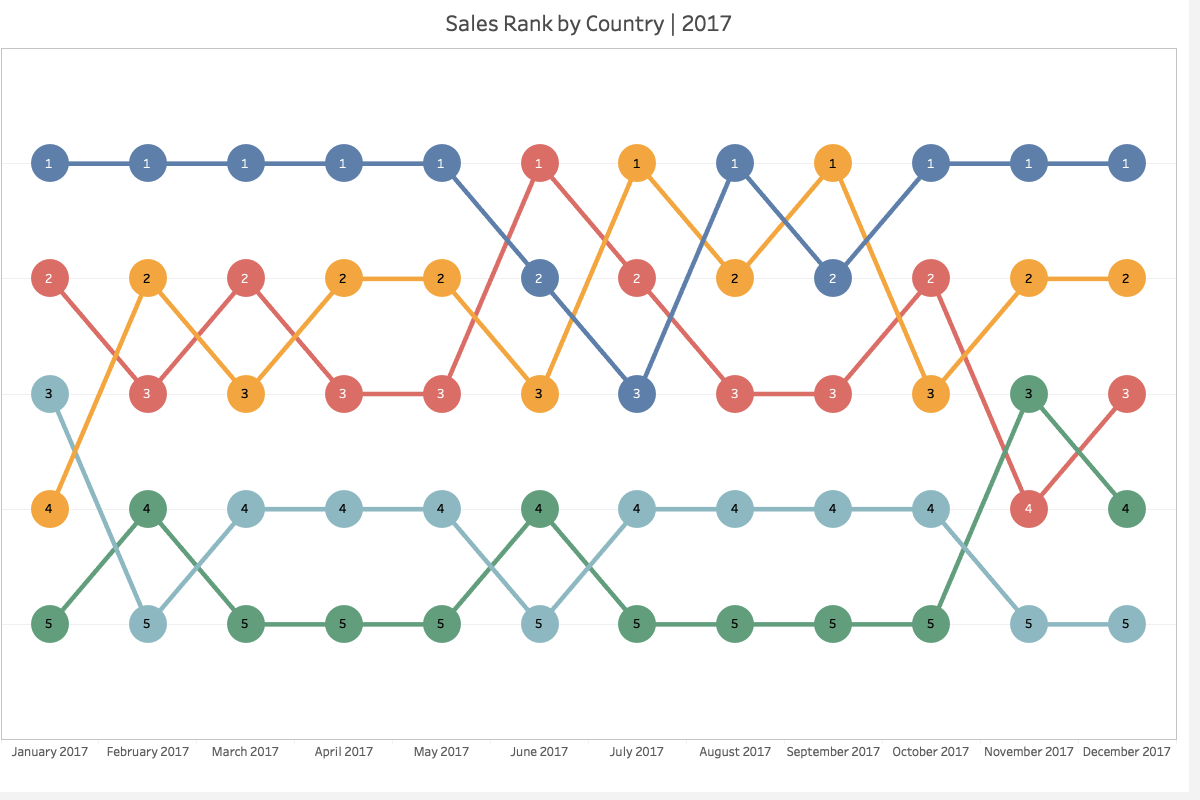Bump charts / Slope charts are an interesting way to show changes in rankings over time, but Power BI does not currently have a good built-in chart for this sort of visualization.

I saw an interesting example of one of these charts recently where the circles in the bump chart also change size based on the relative value of the metric.
There is a video on the Curbal channel showing how you can get pretty close with a line chart, but the circles are all the same size.
And Kerry Kolosko also has an example using deneb on her site. And while the circles are a constant size in her example, I was pretty sure that with a little tweaking I could make Deneb produce the sort of output I wanted.
I started using a copy of the data set from Curbal’s video. I used the existing [Rank bump chart] measure for the rankings and I created a simple Percent of Year measure using the following expression for the labels and sizing of the circles.
Percent of Year = DIVIDE([Sales], CALCULATE([Sales] , all(), values('Calendar'[Year])))And after a bit of experimenting and reading through the Vega and Vega-Lite documentation to figure out how to specify the size encoding for the circles I ended up with the following result which I was pretty pleased with.

Below is the Deneb specification for the above chart
{
"$schema": "https://vega.github.io/schema/vega-lite/v5.json",
"usermeta": {
"deneb": {
"build": "1.4.0.0",
"metaVersion": 1,
"provider": "vegaLite",
"providerVersion": "5.4.0"
},
"interactivity": {
"tooltip": true,
"contextMenu": true,
"selection": false,
"highlight": false,
"dataPointLimit": 50
},
"information": {
"name": "Bump Chart",
"description": "[No Description Provided]",
"author": "Darren Gosbell",
"uuid": "3416d242-19c2-4c88-b369-63d3f8ca302e",
"generated": "2022-12-09T07:05:41.633Z"
},
"dataset": [
{
"key": "__0__",
"name": "Year",
"description": "This is the column for the X-Axis",
"type": "numeric",
"kind": "column"
},
{
"key": "__1__",
"name": "CategoryName",
"description": "This is the column for the Y-Axis",
"type": "text",
"kind": "column"
},
{
"key": "__2__",
"name": "Rank bump chart",
"description": "This is the ranking measure",
"type": "numeric",
"kind": "measure"
},
{
"key": "__3__",
"name": "Percent of Year",
"description": "This is the value to display",
"type": "numeric",
"kind": "measure"
}
]
},
"config": {
"view": {"stroke": "transparent"},
"font": "Segoe UI",
"arc": {},
"area": {
"line": true,
"opacity": 0.6
},
"bar": {},
"line": {
"strokeWidth": 3,
"strokeCap": "round",
"strokeJoin": "round"
},
"path": {},
"point": {
"filled": true,
"size": 75
},
"rect": {},
"shape": {},
"symbol": {
"strokeWidth": 1.5,
"size": 50
},
"text": {
"font": "Segoe UI",
"fontSize": 12,
"fill": "#666666"
},
"axis": {
"ticks": false,
"grid": false,
"domain": false,
"labelColor": "#666666",
"labelFontSize": 12,
"titleFont": "wf_standard-font, helvetica, arial, sans-serif",
"titleColor": "#070f25",
"titleFontSize": 16,
"titleFontWeight": "normal"
},
"axisQuantitative": {
"tickCount": 3,
"grid": true,
"gridColor": "#C8C8C8",
"gridDash": [1, 5],
"labelFlush": false
},
"axisX": {"labelPadding": 5},
"axisY": {"labelPadding": 10},
"header": {
"titleFont": "wf_standard-font, helvetica, arial, sans-serif",
"titleFontSize": 16,
"titleColor": "#070f25",
"labelFont": "Segoe UI",
"labelFontSize": 13.333333333333332,
"labelColor": "#666666"
},
"legend": {
"titleFont": "Segoe UI",
"titleFontWeight": "bold",
"titleColor": "#666666",
"labelFont": "Segoe UI",
"labelFontSize": 13.333333333333332,
"labelColor": "#666666",
"symbolType": "circle",
"symbolSize": 75
}
},
"data": {"name": "dataset"},
"encoding": {
"x": {
"field": "__0__",
"type": "nominal"
},
"y": {
"field": "__2__",
"type": "nominal",
"axis": null
},
"order": {
"field": "__0__",
"type": "nominal"
}
},
"layer": [
{
"name": "Lines Layer",
"mark": {
"type": "line",
"point": false,
"interpolate": "monotone"
},
"encoding": {
"color": {
"field": "__1__",
"legend": false,
"scale": {
"scheme": "pbiColorNominal"
}
}
}
},
{
"name": "Circle Layer",
"mark": {
"type": "circle",
"tooltip": true,
"opacity": 1
},
"encoding": {
"color": {
"field": "__1__",
"legend": false
},
"size": {
"field": "__3__",
"type": "quantitative",
"scale": {
"range": [200, 2000]
},
"legend": null
}
}
},
{
"mark": {
"type": "text",
"color": "white"
},
"encoding": {
"text": {
"field": "__3__",
"format": "0%",
"formatType": "pbiFormat"
}
}
},
{
"transform": [
{
"window": [
{"op": "rank", "as": "rank"}
],
"sort": [
{
"field": "__0__",
"order": "descending"
}
]
},
{"filter": "datum.rank === 1"}
],
"mark": {
"type": "text",
"align": "left",
"baseline": "middle",
"dx": 25,
"fontWeight": "bold",
"fontSize": 12
},
"encoding": {
"text": {
"field": "__1__",
"type": "nominal"
},
"color": {
"field": "__1__",
"scale": {
"scheme": "pbiColorNominal"
},
"legend": false
}
}
},
{
"transform": [
{
"window": [
{"op": "rank", "as": "rank"}
],
"sort": [
{
"field": "__0__",
"order": "ascending"
}
]
},
{"filter": "datum.rank === 1"}
],
"mark": {
"type": "text",
"align": "right",
"baseline": "middle",
"dx": -25,
"fontWeight": "bold",
"fontSize": 12
},
"encoding": {
"text": {
"field": "__1__",
"type": "nominal"
},
"color": {
"field": "__1__",
"scale": {
"scheme": "pbiColorNominal"
},
"legend": false
}
}
}
]
}If you prefer the look of the straight lines between the data points you can simply remove the "interpolate": "monotone" from the lines layer and you end up with a chart like the following one.

Recent Comments